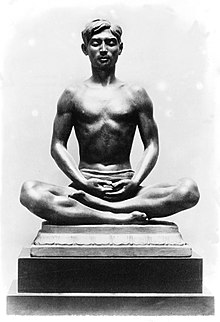
Back ধ্যান (হিন্দু দর্শন) Bengali/Bangla دیانا (هندوئیسم) Persian ध्यान (योग) Hindi Dhjána (hinduizmus) Hungarian ಹಿಂದೂ ಧರ್ಮದಲ್ಲಿ ಧ್ಯಾನ Kannada ध्यान Nepali இந்து சமயத்தில் தியானம் Tamil


| Part of a series on |
| Hinduism |
|---|
 |
Dhyāna (Sanskrit: ध्यान) in Hinduism means contemplation and meditation.[1] Dhyana is taken up in Yoga practices, and is a means to samadhi and self-knowledge.[2]
The various concepts of dhyana and its practice originated in the Sramanic movement of ancient India,[3][4] which started before the 6th century BCE (pre-Buddha, pre-Mahavira),[5][6] and the practice has been influential within the diverse traditions of Hinduism.[7][8] It is, in Hinduism, a part of a self-directed awareness and unifying Yoga process by which the yogi realizes Self (Atman, soul), one's relationship with other living beings, and Ultimate Reality.[7][9][10] Dhyana is also found in other Indian religions such as Buddhism and Jainism. These developed along with dhyana in Hinduism, partly independently, partly influencing each other.[1] All the while similar traditions developed within Zoroastrianism in Persia under the label daena.
The term Dhyana appears in Aranyaka and Brahmana layers of the Vedas but with unclear meaning, while in the early Upanishads it appears in the sense of "contemplation, meditation" and an important part of self-knowledge process.[7][11] It is described in numerous Upanishads of Hinduism,[12] and in Patanjali's Yogasutras - a key text of the Yoga school of Hindu philosophy.[13][14]
- ^ a b Jones & Ryan 2006, pp. 283–284.
- ^ Jones & Ryan 2006, p. 283.
- ^ Bronkhorst 1993, p. 53.
- ^ Cite error: The named reference
sagarmaljain15was invoked but never defined (see the help page). - ^ Cite error: The named reference
reginaldray247was invoked but never defined (see the help page). - ^ Cite error: The named reference
andrewwas invoked but never defined (see the help page). - ^ a b c Cite error: The named reference
williammahonytau171was invoked but never defined (see the help page). - ^ Bronkhorst 1993, pp. 65–83.
- ^ Edwin Bryant (2009), The Yoga sūtras of Patañjali: a new edition, translation, and commentary with insights from the traditional commentators, North Point Press, ISBN 978-0865477360, pages xxii, xxix-xxx
- ^ Wynne 2007, p. 94.
- ^ Cite error: The named reference
staaldtv182was invoked but never defined (see the help page). - ^ Cite error: The named reference
jacobprinupan472was invoked but never defined (see the help page). - ^ Whicher 1998, p. 49.
- ^ Stuart Sarbacker (2011), Yoga Powers (Editor: Knut A. Jacobsen), Brill, ISBN 978-9004212145, page 195
© MMXXIII Rich X Search. We shall prevail. All rights reserved. Rich X Search